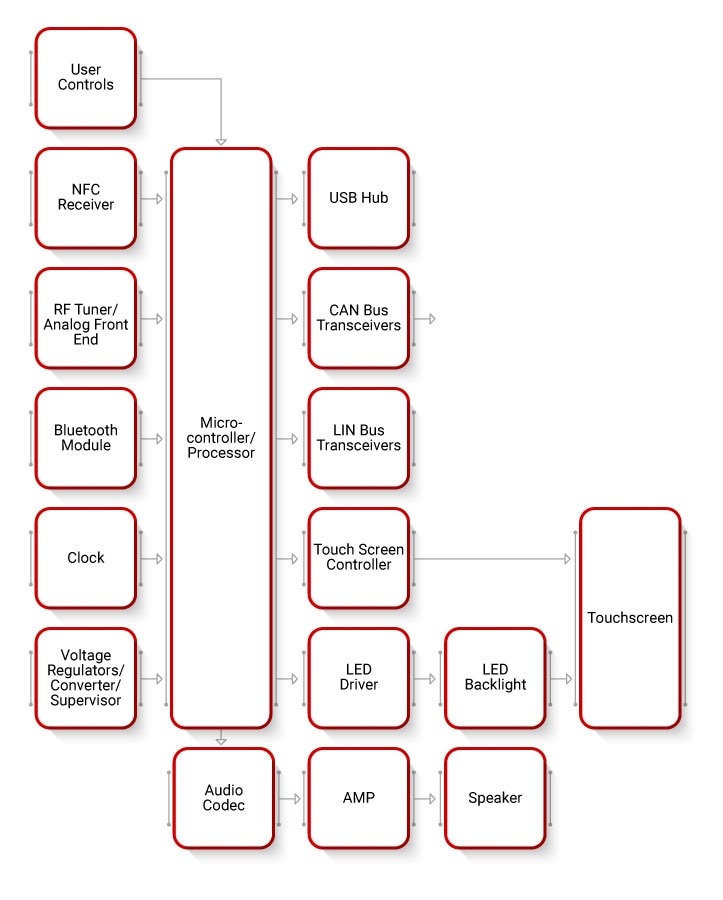Products in the audio amplifier integrated circuit (IC) family are designed specifically for replicating signal-level audio content at increased power levels sufficient to drive headphones, speakers, or similar transducers. Features such as mute inputs, volume controls, and anti-transient (depop) functions distinguish them from general purpose amplifiers. Audio amplifier classes of all types are included such as devices based on Class A, Class D, Class G topologies and others, as well as devices that integrate additional functionality such as analog-to-digital conversion in addition to the amplification function.
RF Transceiver Modules are used to send and/or take in a radio frequency signal. The RF family/Standard is Bluetooth, Cellular, General ISM, GPS, Navigation, SiBeam, WiFi, and 802.15.4 with frequency ranging from 70MHz to 65GHz. The data rates range from 600 bps to 12.3Gbps and a power output from -10dBm to 54dBm.
Logic buffers, drivers, receivers and transceivers allow isolated access to logic signals from one circuit for use in another circuit. Buffers pass their input signal, either unchanged or inverted, to their output and may be used to clean up a weak signal or drive a load. In a boolean logic simulator, a buffer is mainly used to increase propagation delay. Logic receivers and transceivers allow isolated communication between data buses.
CODECs are semiconductor devices used to transform data by compression and decompression. Data compression provides improved transmission speeds and reduced storage space. Some CODECs provide up to 32 bits of resolution and as many as six or eight analog-to-digital and digital-to-analog converters respectively. Sigma-Delta modulation is available as well as I2C, I2S, SPI, Serial, HDA, S/DIF, PCM, USB, AC'97, and SLIMbus data interfaces.
Devices in the LED driver PMIC (Power Management Integrated Circuit) family are used to supply a current flow of controlled value to a load, typically a Light Emitting Diode, from a power source having a nominally fixed voltage. Key differentiators from the very similar products designed for voltage regulation include a characteristically lower feedback voltage (to improve system efficiency) and high prevalence of provisions for external control of the device's operating point, used to implement dimming functions in lighting applications.
Logic buffers, drivers, receivers and transceivers allow isolated access to logic signals from one circuit for use in another circuit. Buffers pass their input signal, either unchanged or inverted, to their output and may be used to clean up a weak signal or drive a load. In a boolean logic simulator, a buffer is mainly used to increase propagation delay. Logic receivers and transceivers allow isolated communication between data buses.
Products in the modular embedded processor family integrate a microcontroller, microprocessor, digital signal processor, FPGA, or other such computational device together with support components such as memory, power management, timing, and other items necessary for their operation. They are suitable and intended for integration into an end product, and offer product developers access to modern computational and interface capabilities without necessity of high speed hardware design experience.
RFID or RF access Monitoring ICs are semiconductor devices configured as RFID (Radio Frequency Identification) readers, transponders, passive entry or passive start processors and TPMS (Tire Pressure Monitoring System). They are designed to comply with specific RFID standards such as EPC, ISO, NFC, MiFARE and FeliCa, and communicate over I2C, SPI, UART, USB, PWM, RS232, RS422, RS485 and other interfaces.
Real Time Clocks (RTCs) provide time and/or date information in almost any electronic device which needs to keep accurate time. The clock types are binary counter, clock/calendar/supervisor, elapsed time counter, phantom time chip, portable system controller, temperature recorder, time event recorder, and timer clock peripheral. They contain memory sizes ranging from 2 B to 2 MB and have interface options of I2C, Parallel, Serial, SPI, 1-Wire, 2-Wire, 3-Wire, and 4-Wire.
Products in this family are integrated circuits that integrate one or more of the functions commonly found in the portion of a radio frequency (RF) signal chain that is connected to the system's antenna, such as a low-noise amplifier (LNA) and programmable amplifier (PA). The actual functionality incorporated into any given device varies, with devices targeting relatively narrow applications typically integrating a larger portion of the requisite signal chain than those intended to be more flexible in their application.
Speaker products are audio frequency electromagnetic transducers used primarily to turn energy in the format of an electrical signal into mechanical compression waves travelling through an atmospheric air environment for reproduction of speech, music, or similar material. Products designed for general purpose reproduction of partial regions of the human audible frequency range (subwoofers, woofers, tweeters, etc.) are included, as well as full range products and special purpose transducers tailored for headset or in-ear applications.
Touch screen controllers are integrated circuits that provide an interface between the touch screen sensor array and the device the screen operates. The controller receives position information from the sensor array which is usually resistive or capacitive. In turn, the position information is passed along to a microcontroller via a serial, parallel, USB, or UART interface.
Products in the DC-DC switching regulator PMIC (Power Management Integrated Circuit) family are component-level devices used in applications requiring stabilization of a DC input voltage and/or transformation thereof to an output voltage of different magnitude. They are distinguished from similar products called "controller" PMICs by virtue of integrating the main switching element through which the power delivered by the device passes.









